Influence of Overlap on Surface Quality in the Laser Polishing of 3D Printed Inconel 718 under the Effect of Air and Argon
Abstract
1. Introduction
2. Materials and Methods
2.1. Characterization of SLM Samples
2.2. Laser Polishing Station and Beam Caustic
2.3. Polishing Strategy and Overlap
2.4. Process Gas
2.5. Surface Analysis
3. Results
3.1. Oxidation Layer
3.2. Influence of Overlap
4. Discussion
5. Conclusions
Author Contributions
Funding
Institutional Review Board Statement
Informed Consent Statement
Data Availability Statement
Acknowledgments
Conflicts of Interest
References
- Abdulhameed, O.; Al-Ahmari, A.; Ameen, W.; Mian, S.H. Additive Manufacturing: Challenges, trends, and applications. Adv. Mech. Eng. 2019, 11, 168781401882288. [Google Scholar] [CrossRef]
- Kruth, J.P.; Froyen, L.; van Vaerenbergh, J.; Mercelis, P.; Rombouts, M.; Lauwers, B. Selective laser melting of iron-based powder. J. Mater. Process. Technol. 2004, 149, 616–622. [Google Scholar] [CrossRef]
- Kurzynowski, T.; Stopyra, W.; Gruber, K.; Ziółkowski, G.; Kuźnicka, B.; Chlebus, E. Effect of scanning and support strategies on relative density of SLM-ed H13 steel in relation to specimen size. Materials 2019, 12, 239. [Google Scholar] [CrossRef]
- Brynk, T.; Pakiela, Z.; Ludwichowska, K.; Romelczyk, B.; Molak, R.M.; Plocinska, M.; Kurzac, J.; Kurzynowski, T.; Chlebus, E. Fatigue crack growth rate and tensile strength of Re modified Inconel 718 produced by means of selective laser melting. Mater. Sci. Eng. A 2017, 698, 289–301. [Google Scholar] [CrossRef]
- Udroiu, R.; Braga, I.C.; Nedelcu, A. Evaluating the quality surface performance of Additive Manufacturing systems: Methodology and a material jetting case study. Materials 2019, 12, 995. [Google Scholar] [CrossRef]
- Kim, U.S.; Park, J.W. High-quality surface finishing of industrial three-dimensional metal Additive Manufacturing using electrochemical polishing. Int. J. Precis. Eng. Manuf. Green Tech. 2019, 6, 11–21. [Google Scholar] [CrossRef]
- Wang, J.; Zhu, J.; Liew, P.J. Material removal in ultrasonic abrasive polishing of additive manufactured components. Appl. Sci. 2019, 9, 5359. [Google Scholar] [CrossRef]
- Shao, T.M.; Hua, M.; Tam, H.Y.; Cheung, E.H. An approach to modelling of Laser Polishing of metals. Surf. Coat. Technol. 2005, 197, 77–84. [Google Scholar] [CrossRef]
- Mohajerani, S.; Bordatchev, E.V.; Tutunea-Fatan, O.R. Recent developments in modeling of Laser Polishing of metallic materials. Lasers Manuf. Mater. Process. 2018, 5, 395–429. [Google Scholar] [CrossRef]
- Ramos, J.A.; Bourell, D.L.; Beaman, J.J. Surface over-melt during Laser Polishing of indirect-SLS metal parts. MRS Proc. 2002, 758. [Google Scholar] [CrossRef]
- Poprawe, R. Tailored Light 2; Springer: Berlin/Heidelberg, Germany, 2011; ISBN 978-3-642-01236-5. [Google Scholar]
- Krishnan, A.; Fang, F. Review on mechanism and process of surface polishing using lasers. Front. Mech. Eng. 2019, 14, 299–319. [Google Scholar] [CrossRef]
- Marimuthu, S.; Triantaphyllou, A.; Antar, M.; Wimpenny, D.; Morton, H.; Beard, M. Laser Polishing of selective laser melted components. Int. J. Mach. Tools Manuf. 2015, 95, 97–104. [Google Scholar] [CrossRef]
- Nüsser, C.; Kumstel, J.; Kiedrowski, T.; Diatlov, A.; Willenborg, E. Process- and material-induced surface structures during Laser Polishing. Adv. Eng. Mater. 2015, 17, 268–277. [Google Scholar] [CrossRef]
- Vadali, M.; Ma, C.; Li, X.; Pfefferkorn, F.E.; Duffie, N.A. Intelligent scan trajectories for pulsed Laser Polishing. Int. J. Mechatron. Manuf. Syst. 2018, 11, 101–119. [Google Scholar] [CrossRef]
- Flemmer, J.; Ross, I.; Willenborg, E.; Fröba, H. Machine tool and CAM-NC data chain for Laser Polishing complex shaped parts. Adv. Eng. Mater. 2015, 17, 260–267. [Google Scholar] [CrossRef]
- Zhou, Y.; Zhao, Z.; Zhang, W.; Xiao, H.; Xu, X. Experiment study of rapid Laser Polishing of freeform steel surface by dual-beam. Coatings 2019, 9, 324. [Google Scholar] [CrossRef]
- Caggiano, A.; Teti, R.; Alfieri, V.; Caiazzo, F. Automated Laser Polishing for surface finish enhancement of additive manufactured components for the automotive industry. Prod. Eng. Res. Devel. 2021, 15, 109–117. [Google Scholar] [CrossRef]
- Alfieri, V.; Argenio, P.; Caiazzo, F.; Vincenzo, S. Reduction of surface roughness by means of laser processing over Additive Manufacturing metal parts. Materials 2016, 10, 30. [Google Scholar] [CrossRef]
- Fan, W.; Yang, Y.; Lou, R.; Chen, X.; Bai, J.; Cao, W.; Cheng, G.; Si, J. Influence of energy fluence and overlapping rate of femtosecond laser on surface roughness of Ti-6Al-4V. Opt. Eng. 2019, 58, 1. [Google Scholar] [CrossRef]
- Bhaduri, D.; Penchev, P.; Batal, A.; Dimov, S.; Soo, S.L.; Sten, S.; Harrysson, U.; Zhang, Z.; Dong, H. Laser Polishing of 3D printed mesoscale components. Appl. Surf. Sci. 2017, 405, 29–46. [Google Scholar] [CrossRef]
- Rosa, B.; Hascoet, J.Y.; Mognol, P. Modeling and optimization of Laser Polishing process. AMM 2014, 575, 766–770. [Google Scholar] [CrossRef]
- Hafiz, A.M.K.; Bordatchev, E.V.; Tutunea-Fatan, R.O. Influence of overlap between the laser beam tracks on surface quality in Laser Polishing of AISI H13 tool steel. J. Manuf. Process. 2012, 14, 425–434. [Google Scholar] [CrossRef]
- Rosa, B.; Mognol, P.; Hascoët, J. Modelling and optimization of Laser Polishing of additive laser manufacturing surfaces. Rapid Prototyp. J. 2016, 22, 956–964. [Google Scholar] [CrossRef]
- Yung, K.C.; Wang, W.J.; Xiao, T.Y.; Choy, H.S.; Mo, X.Y.; Zhang, S.S.; Cai, Z.X. Laser Polishing of additive manufactured CoCr components for controlling their wettability characteristics. Surf. Coat. Technol. 2018, 351, 89–98. [Google Scholar] [CrossRef]
- Bustillo, A.; Ukar, E.; Rodriguez, J.J.; Lamikiz, A. Modelling of process parameters in Laser Polishing of steel components using ensembles of regression trees. Int. J. Comp. Integr. Manuf. 2011, 24, 735–747. [Google Scholar] [CrossRef]
- Pilipović, A.; Brajlih, T.; Drstvenšek, I. Influence of processing parameters on tensile properties of SLS polymer product. Polymers 2018, 10, 1208. [Google Scholar] [CrossRef]
- Temmler, A.; Liu, D.; Preußner, J.; Oeser, S.; Luo, J.; Poprawe, R.; Schleifenbaum, J.H. Influence of Laser Polishing on surface roughness and microstructural properties of the remelted surface boundary layer of tool steel H11. Mater. Design 2020, 192, 108689. [Google Scholar] [CrossRef]
- Temmler, A.; Ross, I.; Luo, J.; Jacobs, G.; Schleifenbaum, J.H. Influence of global and local process gas shielding on surface topography in laser micro polishing (LμP) of stainless steel 410. Surf. Coat. Technol. 2020, 403, 126401. [Google Scholar] [CrossRef]
- Perry, T.L.; Werschmoeller, D.; Li, X.; Pfefferkorn, F.E.; Duffie, N.A. Pulsed Laser Polishing of micro-milled Ti6Al4V samples. J. Manuf. Process. 2009, 11, 74–81. [Google Scholar] [CrossRef]
- dos Santos Solheid, J.; Jürgen Seifert, H.; Pfleging, W. Laser surface modification and polishing of additive manufactured metallic parts. Proc. CIRP 2018, 74, 280–284. [Google Scholar] [CrossRef]
- Bures, M.; Zetek, M. Application of laser surface polishing on additvie manufactured parts of inconel 718 nickel-based superalloy. MM SJ 2020, 2020, 3873–3877. [Google Scholar] [CrossRef]
- Perry, T.L.; Werschmoeller, D.; Duffie, N.A.; Xiaochun, L.; Pfefferkorn, F.E. Examination of selective pulsed laser micropolishing on microfabricated nickel samples using spatial frequency analysis. J. Manuf. Sci. Eng. 2009, 131, 021002. [Google Scholar] [CrossRef]
- Willenborg, E. Polieren von Werkzeugstählen mit Laserstrahlung; Shaker Verlag: Herzogenrath, Germany, 2006; ISBN 978-3-8322-4896-3. [Google Scholar]
- Temmler, A.; Liu, D.; Luo, J.; Poprawe, R. Influence of pulse duration and pulse frequency on micro-roughness for laser micro polishing (LµP) of stainless steel AISI 410. Appl. Surf. Sci. 2020, 510, 145272. [Google Scholar] [CrossRef]
- Ross, I.; Temmler, A.; Willenborg, E.; Poprawe, R.; Teller, M. Investigation of the influence of laser surface modifications on the adhesive wear behavior in dry cold extrusion of aluminum. Lasers Manuf. Conf. 2015, 2015, 10. [Google Scholar]
- Paulonis, D.F.; Schirra, J.J. Alloy 718 at Pratt & Whitney–Historical perspective and future challenges. Superalloys 2001. [Google Scholar] [CrossRef]
- Zhihao, F.; Libin, L.; Longfei, C.; Yingchun, G. Laser Polishing of additive manufactured superalloy. CIRP Conf. Surf. Integr. 2018, 71, 150–154. [Google Scholar] [CrossRef]
- Sanviemvongsak, T.; Monceau, D.; Macquaire, B. High temperature oxidation of IN 718 manufactured by laser beam melting and electron beam melting: Effect of surface topography. Corros. Sci. 2018, 141, 127–145. [Google Scholar] [CrossRef]
- Kumstel, J.; Kirsch, B. Polishing titanium- and nickel-based alloys using Cw-laser radiation. Phys. Proc. 2013, 41, 362–371. [Google Scholar] [CrossRef]
- Hu, G.; Song, Y.; Guan, Y. Tailoring metallic surface properties induced by laser surface processing for industrial applications. Nanotechnol. Precis. Eng. 2019, 2, 29–34. [Google Scholar] [CrossRef]
- Dadbakhsh, S.; Hao, L.; Kong, C.Y. Surface finish improvement of LMD samples using Laser Polishing. Virtual Phys. Prototyp. 2010, 5, 215–221. [Google Scholar] [CrossRef]
- Temmler, A.; Schmickler, T.; Willenborg, E. Surface structuring by laser remelting of Inconel 718. In Proceedings of the Lasers in Manufacturing Conference, Munich, Germany, 22–25 June 2015. [Google Scholar]
- Zhang, D.; Yu, J.; Li, H.; Zhou, X.; Song, C.; Zhang, C.; Shen, S.; Liu, L.; Dai, C. Investigation of Laser Polishing of four selective laser melting alloy samples. Appl. Sci. 2020, 10, 760. [Google Scholar] [CrossRef]
- Fraunhofer Institute for Laser Technology ILT. Laser Polishing of SLM Components out of Inconel 718. Available online: www.ilt.fraunhofer.de (accessed on 16 March 2021).
- Greene, G.A.; Finfrock, C.C. Oxidation of inconel 718 in air at high temperatures. Oxid. Metals 2001, 55, 505–521. [Google Scholar] [CrossRef]
- Yu, H.; Hayashi, S.; Kakehi, K.; Kuo, Y.-L. Study of formed oxides in IN718 alloy during the fabrication by selective laser melting and electron beam melting. Metals 2019, 9, 19. [Google Scholar] [CrossRef]
- Temmler, A.; Comiotto, M.; Ross, I.; Kuepper, M.; Liu, D.M.; Poprawe, R. Surface structuring by laser remelting of 1.2379 (D2) for cold forging tools in automotive applications. J. Laser Appl. 2019, 31, 22017. [Google Scholar] [CrossRef]
- Zhang, Y.N.; Cao, X.; Wanjara, P.; Medraj, M. Oxide films in laser additive manufactured Inconel 718. Acta Mater. 2013, 61, 6562–6576. [Google Scholar] [CrossRef]
- Gasper, A.; Szost, B.; Wang, X.; Johns, D.; Sharma, S.; Clare, A.T.; Ashcroft, I.A. Spatter and oxide formation in laser powder bed fusion of Inconel 718. Addit. Manuf. 2018, 24, 446–456. [Google Scholar] [CrossRef]
- Guan, Y.C.; Zhou, W.; Li, Z.L.; Zheng, H.Y. Influence of overlapping tracks on microstructure evolution and corrosion behavior in laser-melt magnesium alloy. Mater. Design 2013, 52, 452–458. [Google Scholar] [CrossRef]
- Martan, J.; Cibulka, O.; Semmar, N. Nanosecond pulse laser melting investigation by IR radiometry and reflection-based methods. Appl. Surf. Sci. 2006, 253, 1170–1177. [Google Scholar] [CrossRef]
- Schafrik, R.E.; Ward, D.D.; Groh, J.R. Application of alloy 718 in GE aircraft engines: Past, present and next five years. In Superalloys 718, 625, 706 and Various Derivatives (2001); Minerals, Metals and Materials Society: Pittsburgh, PA, USA, 2001; pp. 1–11. ISBN 0-87339-510-7. [Google Scholar]
- Kassner, M.E. Fundamentals of Creep in Metals and Alloys, 2nd ed.; Elsevier: Amsterdam, The Netherlands, 2009; ISBN 9780080914992. [Google Scholar]
- Wang, M.; Du, J.; Deng, Q. The Mechanism of creep during crack propagation of a superalloy under fatigue-creep-environment interactions. Materials 2020, 13, 4418. [Google Scholar] [CrossRef] [PubMed]
- Li, X.; Dong, J.X.; Zhang, L.N.; Guo, W.M. Effects of fatigue dwell time and solid solution on crack growth rate of PM Rene’ 95 superalloy at high temperature. Acta Metall. Sin. 2001, 37, 1059–1063. [Google Scholar]
- Xue, L.; Wang, J.; Li, L.; Chen, G.; Sun, L.; Yu, S. Enhancement of wear and erosion-corrosion resistance of Inconel 718 alloy by liquid nitriding. Mater. Res. Express 2020, 7, 96510. [Google Scholar] [CrossRef]
- Maniee, A.; Mahboubi, F.; Soleimani, R. Improved hardness, wear and corrosion resistance of inconel 718treated by hot wall plasma nitriding. Met. Mater. Int. 2020, 26, 1664–1670. [Google Scholar] [CrossRef]

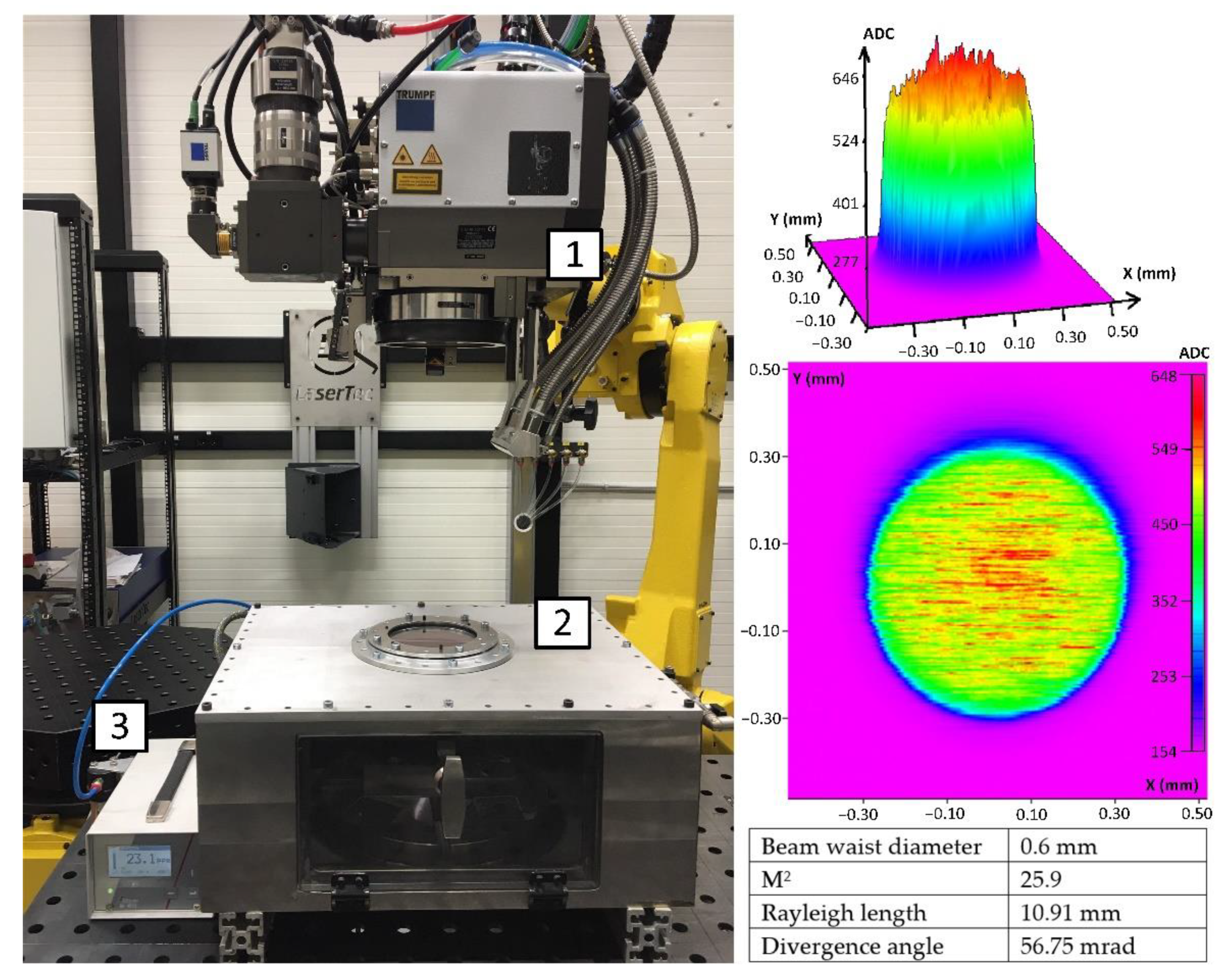



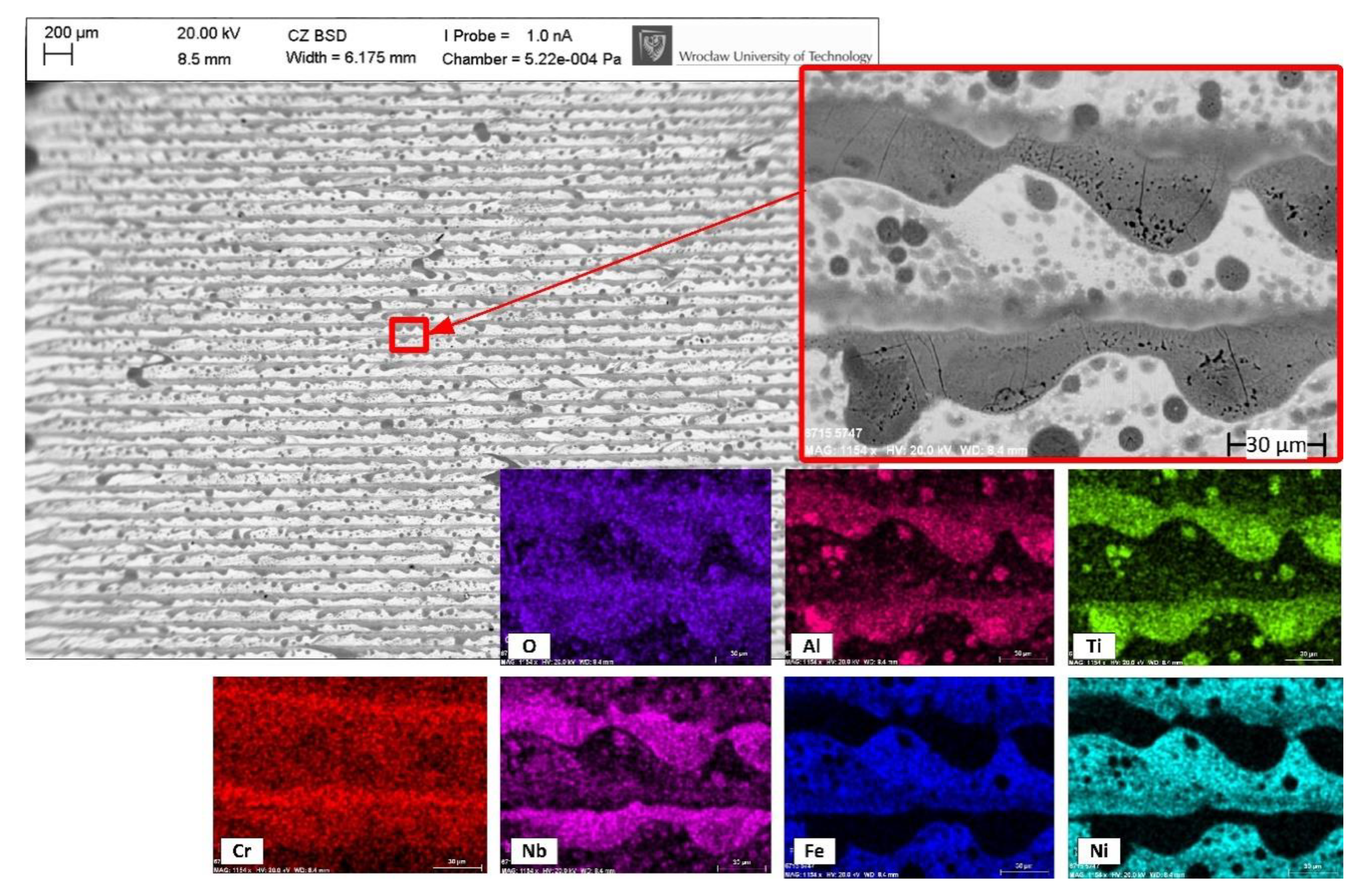
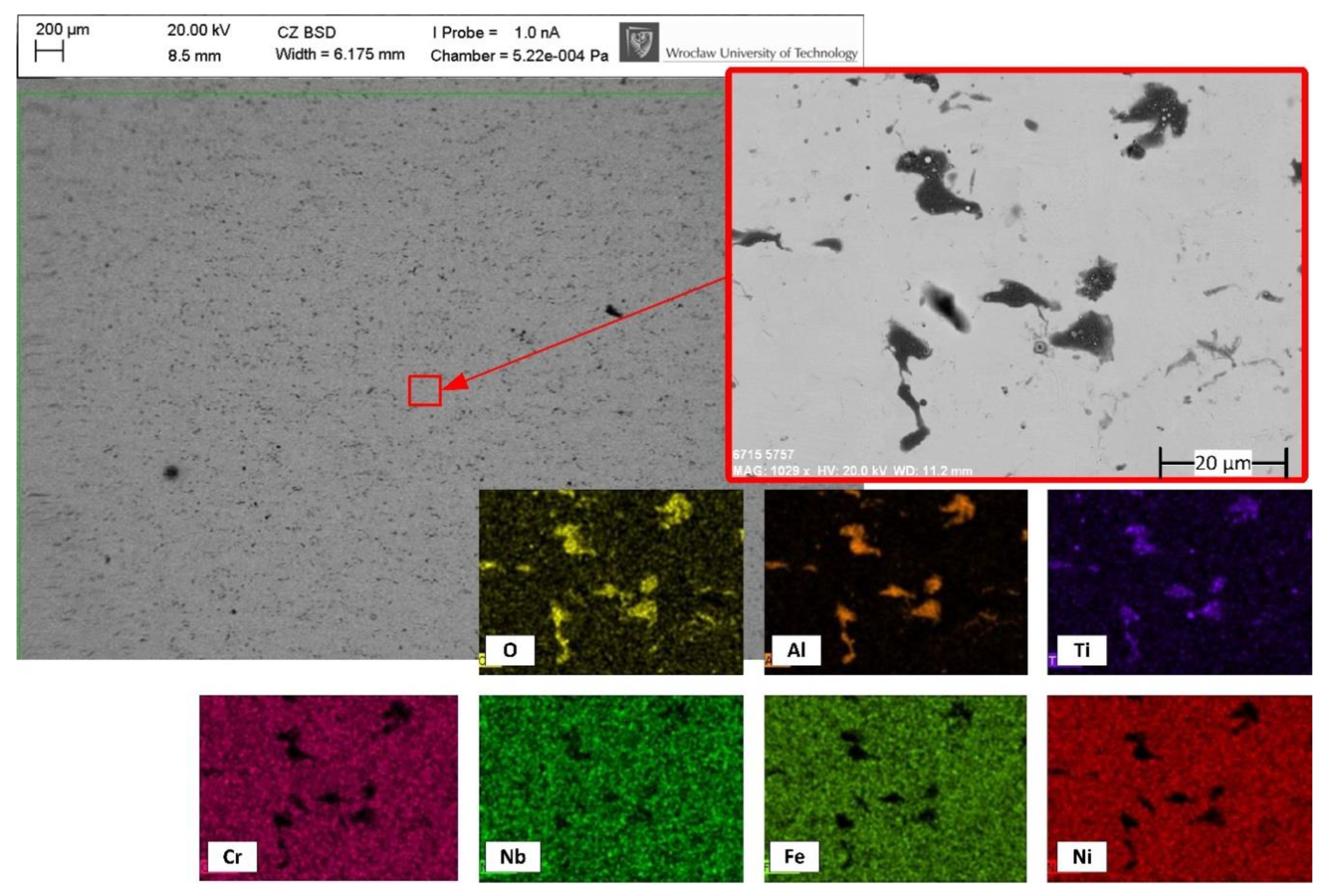


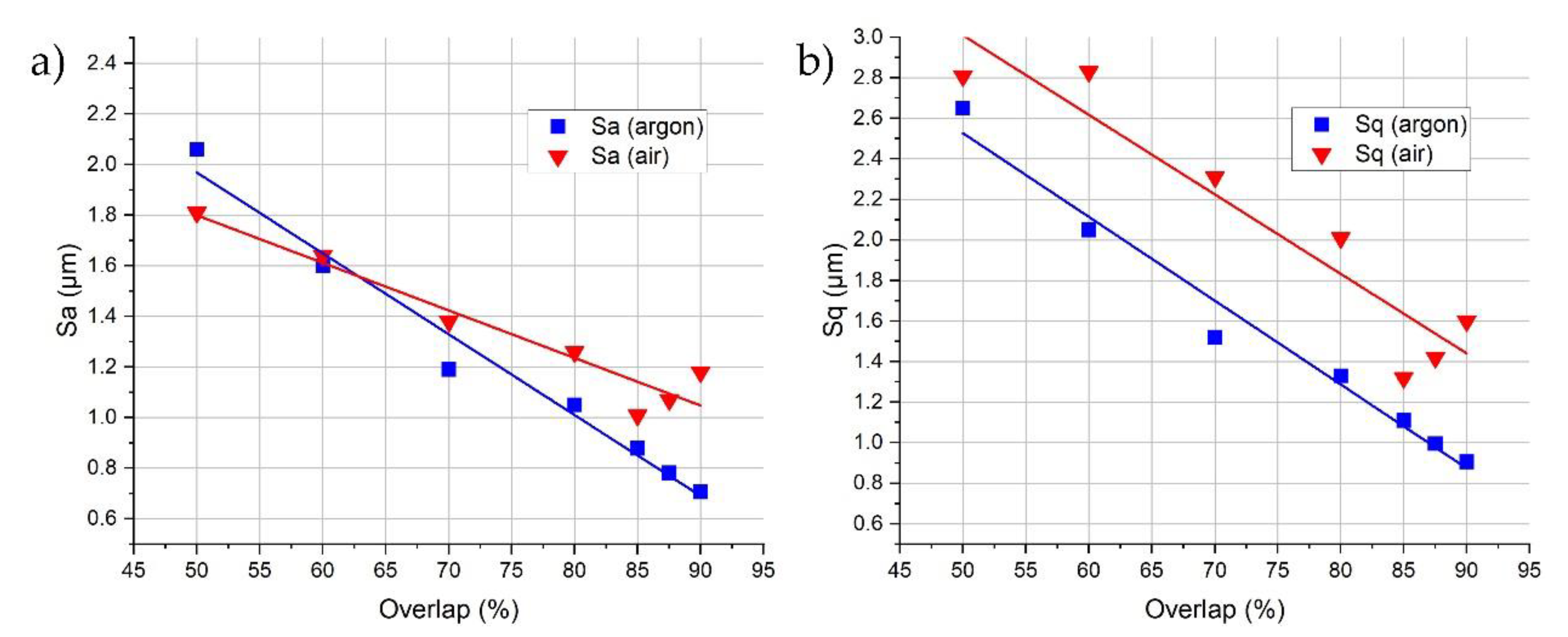
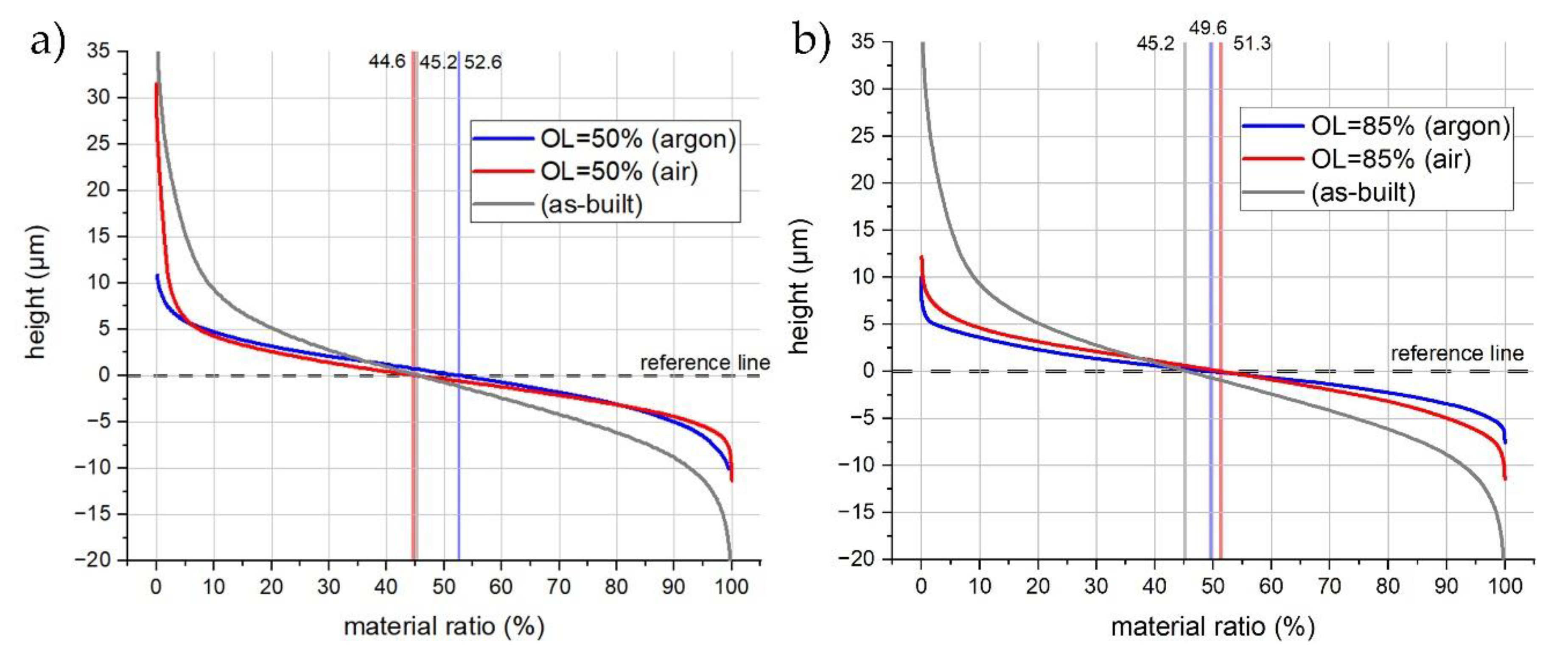
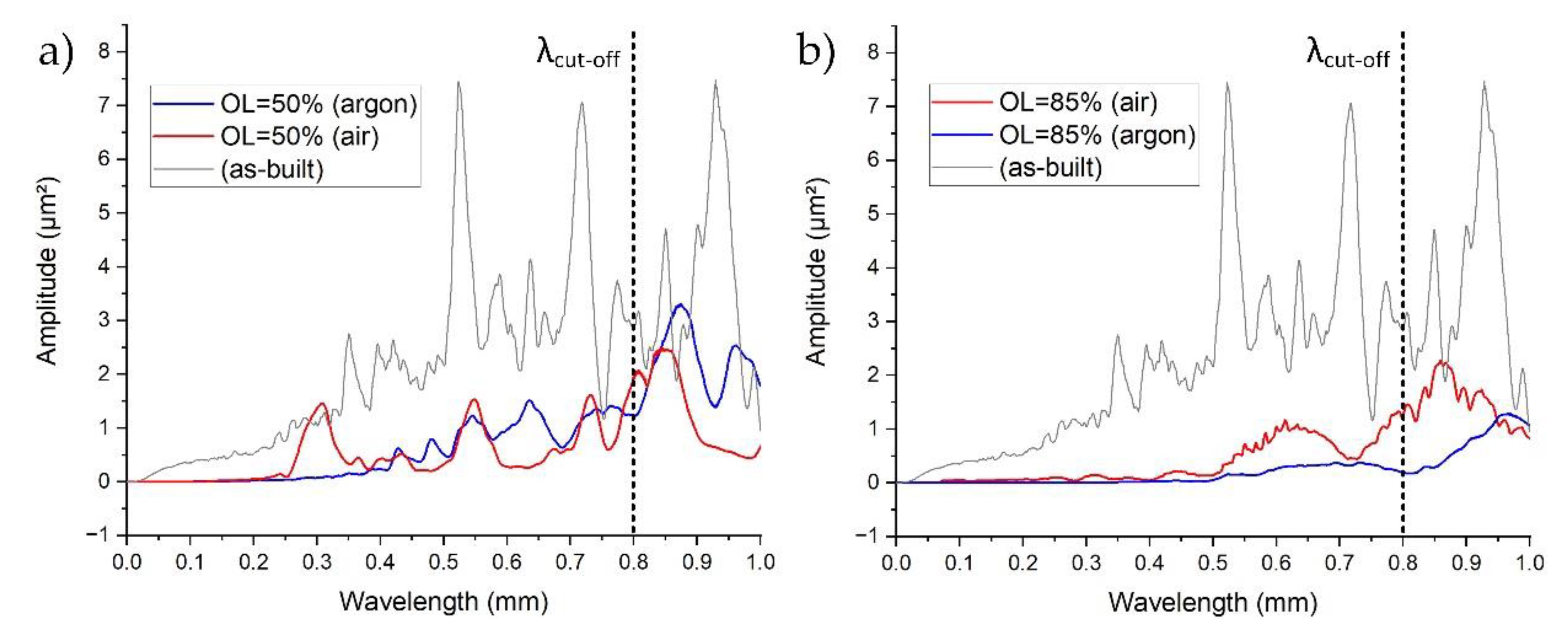
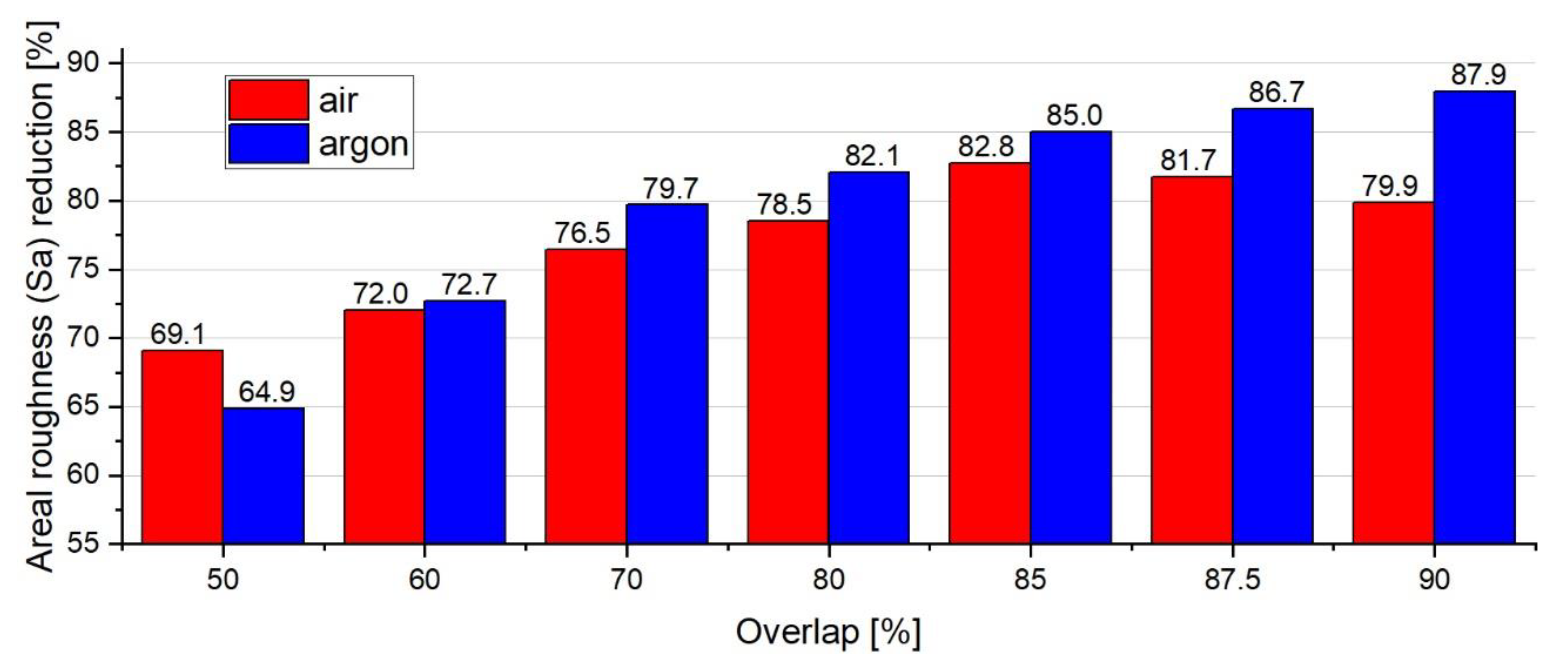
| SLM Manufacturing Parameters | ||||||
|---|---|---|---|---|---|---|
| Beam Focus | Scan Hatching | Scanning Speed | Power | Layer (Thickness) | ||
| 100 µm | 80 µm | 1300 mm/s | 300 W | 30 µm | ||
| Strategy | ||||||
| Strategy | Scan Rotation Angle | Scan Vector Rotation Limitation Window | ||||
| Stripes 7 mm | 45° | From 45° and 135° (in relation to the gas flow vector) | ||||
| IN718 powder chemical composition in wt% | ||||||
| Ni | Cr | Nb | Mo | Ti | Co | Al |
| 50–55 | 17–21 | 4.75–5.50 | 2.80–3.30 | 0.65–1.15 | 1.00 | 0.20–0.80 |
| Si, Mn | Cu | C | B | P, S | Fe | – |
| 0.35 each | 0.3 | 0.08 | 0.006 | 0.015 each | balance | – |
| Test No. | Process Gas | Overlap % | Energy Density J/mm2 | Laser Power W | Scanning Speed mm/s |
|---|---|---|---|---|---|
| 1.a/1.o | Argon (a)/Oxygen (o) | 50 | 7.11 | 160 | 150 |
| 2.a/2.o | 60 | 11.11 | |||
| 3.a/3.o | 70 | 19.75 | |||
| 4.a/4.o | 80 | 44.44 | |||
| 5.a/5.o | 85 | 79.01 | |||
| 6.a/6.o | 87.5 | 113.78 | |||
| 7.a/7.o | 90 | 177.78 |
| Criteria | Gas | Overlap [%] | ||||||
|---|---|---|---|---|---|---|---|---|
| 50 | 60 | 70 | 80 | 85 | 87.5 | 90 | ||
| Visual inspection | Air | No gloss effect. Visible individual laser tracks (bulges) and Ti/Al oxides. | No gloss effect. Individual laser tracks not visible. | |||||
| Argon | The higher the overlap, the higher the gloss effect. Individual laser tracks not visible. | |||||||
| Oxidation layer | Air | Approximately 100 large Ti/Al oxides per 100 mm2 area. Microcracks. | Ti/Al oxides mainly on the edges of the LP area. Microcracks. | |||||
| Argon | Low slope linear oxidation. Occurrence of minor Ti/Al oxides. No microcracking. | |||||||
| Power Spectral Density | Air | Peaks at wavelengths equal to the hatching pitch (bulges) | Peaks at longer wavelengths (surf. deform.) | |||||
| Argon | Shorter wavelengths (roughness) decreased. Peaks at the wavelength above cut-off (surf. waviness) | |||||||
| Abbott-Firestone | Air | Steep slope at upswing (Ti/Al oxides). Low mid. section slope | Steep slope at downswing (surf.deform.). Low mid slope | |||||
| Argon | Uniform amplitude distribution (similar upswing and downswing). Low mid. section slope. | |||||||
| Process efficiency [mm2/s] | Air | 45 | 36 | 27 | 18 | 13.5 | 11.25 | 9 |
| Argon | ||||||||
Publisher’s Note: MDPI stays neutral with regard to jurisdictional claims in published maps and institutional affiliations. |
© 2021 by the authors. Licensee MDPI, Basel, Switzerland. This article is an open access article distributed under the terms and conditions of the Creative Commons Attribution (CC BY) license (http://creativecommons.org/licenses/by/4.0/).
Share and Cite
Ćwikła, M.; Dziedzic, R.; Reiner, J. Influence of Overlap on Surface Quality in the Laser Polishing of 3D Printed Inconel 718 under the Effect of Air and Argon. Materials 2021, 14, 1479. https://doi.org/10.3390/ma14061479
Ćwikła M, Dziedzic R, Reiner J. Influence of Overlap on Surface Quality in the Laser Polishing of 3D Printed Inconel 718 under the Effect of Air and Argon. Materials. 2021; 14(6):1479. https://doi.org/10.3390/ma14061479
Chicago/Turabian StyleĆwikła, Michał, Robert Dziedzic, and Jacek Reiner. 2021. "Influence of Overlap on Surface Quality in the Laser Polishing of 3D Printed Inconel 718 under the Effect of Air and Argon" Materials 14, no. 6: 1479. https://doi.org/10.3390/ma14061479
APA StyleĆwikła, M., Dziedzic, R., & Reiner, J. (2021). Influence of Overlap on Surface Quality in the Laser Polishing of 3D Printed Inconel 718 under the Effect of Air and Argon. Materials, 14(6), 1479. https://doi.org/10.3390/ma14061479








